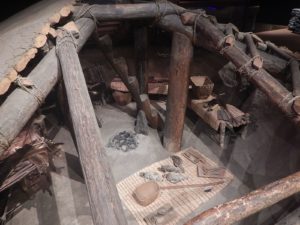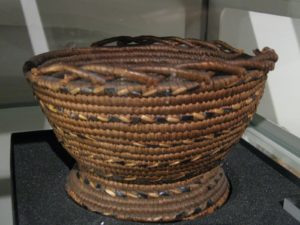Read the Following Selection
Read the following selection, or click on the play button below to listen aloud.
Peoples of the Plateau
The Peoples of the Plateau lived in what is today British Columbia, between the Coast Mountains and the Rocky Mountains. Ktunaxa (Kootenay), Okanagan, Secwepemc (Shuswap), and Stl’atl’imx (Lillooet) were some of the peoples who lived here. They travelled around to hunt and gather plants but in winter came back to their villages.
Life on the Plateau
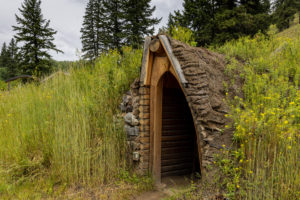
Pit house
Much of the year, Plateau peoples lived in lean-tos, lodges, or tipis. But in the winter, they stayed in pit homes that were partially underground. These looked like large domes covered with earth and tree boughs. A notched log sticking out the hole at the top of the dome helped people climb down into the home. Several families lived in each pit house.
Hunting and Preserving
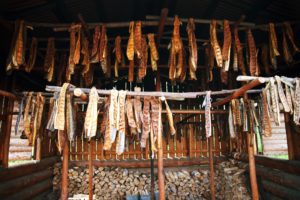
Salmon drying in a smokehouse
The many rivers in the area teemed with salmon and the Peoples of the Plateau had many ways of catching them. They harpooned fish, standing on specific fishing rocks whose location they passed down through generations of families. Or, fishermen dipped fishing nets into the water to catch the salmon. The people also speared the fish or trapped fish in woven baskets.
To preserve the fish so it could be eaten throughout the long, cold winter, the Peoples of the Plateau dried the fish in the open air or in a smokehouse.
The Plateau First Nations also hunted, using bows and arrows, spears, and traps to catch black bears, elk, mountain goats, and other animals. Women gathered berries, lichen, nuts, roots, and more. Some were eaten right away, while others were preserved and kept for the winter.
On Land or Water

Bear paw snowshoes
There are many rapids and fast rivers in the Plateau area, so travelling by water could be dangerous. Most of the First Nations here walked, often carrying heavy packs along the well-used trails. In winter, they loaded packs onto toboggans and trekked through the deep snow on snowshoes. They strapped on round “bear paw” snowshoes when carrying heavy loads, and longer, thinner snowshoes when they wanted to move faster.
On calm waters, these First Nations used rafts and bull boats. These were large, round boats made by stretching animal skin over a wood frame.
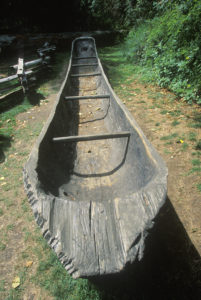
Dugout canoe
Peoples of the Plateau also used dugout canoes (carved from birch, cedar, or pine), as well as sturgeon-nosed canoes. These had pointed tips that sat just above the waterline. The unique shape helped keep water out of the canoe as it went through rapids or lakes.
In the 1730s, horses arrived in the area from the south. They made travel much faster and easier because they could carry people and packs. The Ktunaxa people were the first of the Plateau First Nations to ride horses.
Beautiful Baskets
The Stl’atl’imx peoples are one of the groups still known for the baskets they make from cedar tree roots. These tightly woven baskets are made waterproof by soaking in water. Then they can be used as cooking pots or for carrying goods. They are intricately decorated with black and red patterns.
Now, show what you know!
Complete some questions about the reading selection by clicking “Begin Questions” below.

